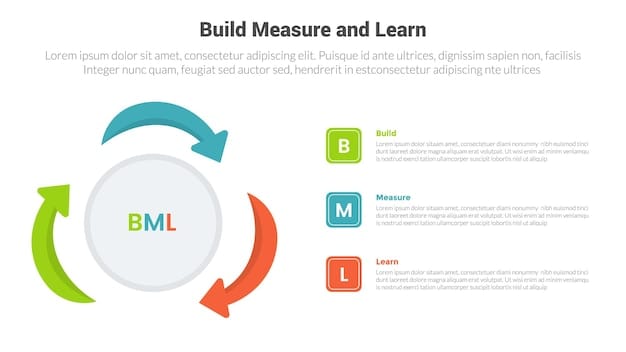The Lean Startup: Achieving Product-Market Fit in 90 Days

The Lean Startup methodology is a scientific approach to building and launching startups, focusing on rapid experimentation, validated learning, and iterative product development to achieve product-market fit within approximately 90 days.
The Lean Startup methodology: Achieve Product-Market Fit in 90 Days offers a streamlined approach to launching businesses, emphasizing validated learning, scientific experimentation, and iterative releases. Instead of building a product and then hoping someone wants it, this methodology prioritizes customer feedback and continuous improvement.
Understanding the Lean Startup Methodology
The Lean Startup isn’t just a trendy buzzword; it’s a robust framework designed to minimize waste and maximize learning. Rooted in lean manufacturing principles, this methodology transforms how startups approach product development. It champions a build-measure-learn feedback loop designed to quickly test assumptions and adapt to real-world customer needs.
Core Principles of Lean Startup
At the heart of the Lean Startup methodology are several fundamental principles, which guide startups in navigating the inherent uncertainties of launching a new venture.
- Validated Learning: Emphasizing empirical progress through customer feedback and data analysis.
- Build-Measure-Learn: A cyclical process involving turning ideas into products, measuring customer reaction, and gleaning insights.
- Minimum Viable Product (MVP): Launching a product with just enough features to attract early-adopter customers and validate product ideas early.
These principles encourage founders to challenge conventional wisdom and embrace continuous learning, ensuring that their product development efforts are aligned with actual customer needs and market demands.

Understanding these core concepts is the first step of implementing the lean startup methodology: Achieve Product-Market Fit in 90 Days.
Why the Lean Startup Approach Matters
In the hyper-competitive landscape of modern startups, the Lean Startup approach isn’t just an option—it’s often a requirement for survival. By emphasizing speed, efficiency, and customer-centricity, this methodology significantly increases the likelihood of building a successful, sustainable business.
The Lean Startup methodology: Achieve Product-Market Fit in 90 Days, is critical because:
- Reduces Waste: Focuses resources on features customers actually value, cutting down on unnecessary development.
- Accelerates Learning: Provides a structured way to gather and act on customer feedback.
- Minimizes Risk: Allows for early course correction, reducing the chances of building a product no one wants.
By embracing the Lean Startup approach, entrepreneurs can avoid common pitfalls and increase their chances of achieving product-market fit within a reasonable timeframe. The Lean Startup methodology: Achieve Product-Market Fit in 90 Days, enables founders to make data-driven decisions and iterate their way to success, rather than relying on intuition or guesswork.
The 90-Day Sprint: Setting the Stage
Aiming to achieve product-market fit in just 90 days may seem ambitious, but it’s entirely feasible with a disciplined application of Lean Startup principles. This timeframe creates a sense of urgency and forces a laser-like focus on the essential tasks.
Creating a structured 90-day plan is key:
Week 1-3: Customer Discovery and Problem Validation
Start by identifying your target customer and getting to know their pain points. Conduct interviews and surveys to understand what problems they’re facing and whether they’re actively seeking a solution. This phase helps you determine if your product idea is worth pursuing. It’s important to identify the customers true, specific needs, which is the first step to The Lean Startup methodology: Achieve Product-Market Fit in 90 Days.

Week 4-6: Building Your MVP
With a clear understanding of your customer’s needs, it’s time to build your Minimum Viable Product (MVP). Remember, the goal of the MVP isn’t to launch a perfect product but to create something that delivers core value and allows you to test your assumptions. This phase should focus on building the minimal things needed to get the ball rolling in The Lean Startup methodology: Achieve Product-Market Fit in 90 Days.
Week 7-9: Testing and Iteration
Once your MVP is ready, get it into the hands of your target customers and gather feedback. Use analytics tools to track user behavior and identify areas for improvement. The insights you gather will inform your next iteration of the product. The Lean Startup methodology: Achieve Product-Market Fit in 90 Days is not possible without rigorous testing.
Week 10-12: Defining Product-Market Fit
Determine whether the data from your experiments and analyses show that your product satisfies a real market need. The Lean Startup methodology: Achieve Product-Market Fit in 90 Days should result in a conclusion, answering whether the current product configuration should be continued, or pivoted with a new MVP.
By breaking down the 90-day sprint into distinct phases, you can stay on track and ensure that your efforts are aligned with your ultimate goal.
Tools and Techniques for Rapid Experimentation
To achieve product-market fit in 90 days, it’s essential to leverage tools and techniques that facilitate rapid experimentation and learning.
This can be done with:
- A/B Testing: Compare different versions of your product or marketing materials to see which performs best.
- Landing Pages: Create simple landing pages to test demand for your product before you even build it.
- Customer Surveys: Gather feedback from your target audience to validate assumptions.
These tools enable you to efficiently test hypotheses, gather data, and make informed decisions about your product development efforts. If your analytics dont reflect the need for the product, The Lean Startup methodology: Achieve Product-Market Fit in 90 Days assumes the team has the ability to iterate a new MVP. The Lean Startup Methodology: Achieve Product-Market Fit in 90 Days.
Metrics That Matter: Tracking Progress
Measuring the right metrics is crucial for understanding whether you’re making progress toward product-market fit. While vanity metrics may look impressive, they don’t necessarily translate into real business value.
Some useful metrics are:
- Customer Acquisition Cost (CAC): The cost of acquiring a new customer.
- Customer Lifetime Value (CLTV): The total revenue you can expect from a single customer.
- Net Promoter Score (NPS): A measure of customer loyalty and willingness to recommend your product.
By tracking these metrics, you can gain insights into the health of your business and make data-driven decisions about where to focus your efforts. One of the primary reasons The Lean Startup methodology: Achieve Product-Market Fit in 90 Days is so valuable relies on quantitative metrics guiding pivots. The Lean Startup methodology: Achieve Product-Market Fit in 90 Days is not possible without adequate data.
Overcoming Common Challenges
While the Lean Startup methodology: Achieve Product-Market Fit in 90 Days framework offers a structured approach to building a startup, it’s not without its challenges. One common obstacle is resistance to change. Many entrepreneurs find it difficult to abandon their initial ideas, even when faced with evidence that they’re not resonating with customers.
Other challenges include:
- Analysis Paralysis: Getting bogged down in data and failing to take action.
- Premature Scaling: Scaling up before achieving product-market fit.
These can also be avoided with good leadership and a solid data driven approach to The Lean Startup methodology: Achieve Product-Market Fit in 90 Days.
| Key Point | Brief Description |
|---|---|
| 🚀 Rapid Experimentation | Quickly test ideas to validate assumptions and reduce waste. |
| 💡 Minimum Viable Product | Launch a basic version of your product to gather early feedback. |
| 📊 Data-Driven Decisions | Use metrics to track progress and adjust strategy as needed. |
| 🎯 Customer-Centric Approach | Focus on solving customer problems and meeting market demands. |
Frequently Asked Questions
Product-market fit is the degree to which a product satisfies the demands of its target market. It’s achieved when a sufficient number of people want and need a product.
An MVP lets you test your assumptions about your product with real users. It offers a quick and affordable way to validate whether your product solves a genuine need and helps achieve product-market fit.
The 90-day sprint gives you a solid starting point, but achieving product-market fit might take longer, that’s ok. Continue iterating, gathering feedback, and adjusting your approach as needed to achieve product-market fit.
Software and tech startups, and any organization dealing with new product development where uncertainty and rapid change are common, enjoy the most gains via The Lean Startup Methodology: Achieve Product-Market Fit in 90 Days.
If the metrics hint at a failing product, its time to **”pivot.”** which is a dramatic shift in strategy. The company could choose a new MVP or focus on a different, emerging customer need that is found through market research.
Conclusion
The Lean Startup methodology: Achieve Product-Market Fit in 90 Days offers a concrete framework for startups to efficiently validate ideas, build products, and iterate based on customer feedback. By embracing rapid experimentation and data-driven decision-making, entrepreneurs can increase their chances of building successful, sustainable businesses that meet real market needs.





